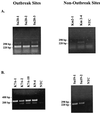In situ detection of the Clostridium botulinum type C1 toxin gene in wetland sediments with a nested PCR assay
- PMID: 10388729
- PMCID: PMC91482
- DOI: 10.1128/AEM.65.7.3240-3243.1999
In situ detection of the Clostridium botulinum type C1 toxin gene in wetland sediments with a nested PCR assay
Abstract
A nested PCR was developed for detection of the Clostridium botulinum type C1 toxin gene in sediments collected from wetlands where avian botulism outbreaks had or had not occurred. The C1 toxin gene was detected in 16 of 18 sites, demonstrating both the ubiquitous distribution of C. botulinum type C in wetland sediments and the sensitivity of the detection assay.
Figures


Similar articles
-
Environmental factors influencing the prevalence of a Clostridium botulinum type C/D mosaic strain in nonpermanent Mediterranean wetlands.Appl Environ Microbiol. 2013 Jul;79(14):4264-71. doi: 10.1128/AEM.01191-13. Epub 2013 May 3. Appl Environ Microbiol. 2013. PMID: 23645197 Free PMC article.
-
Biodiversity of Clostridium botulinum type E associated with a large outbreak of botulism in wildlife from Lake Erie and Lake Ontario.Appl Environ Microbiol. 2011 Feb;77(3):1061-8. doi: 10.1128/AEM.01578-10. Epub 2010 Nov 29. Appl Environ Microbiol. 2011. PMID: 21115703 Free PMC article.
-
Real-time polymerase chain reaction for the detection of toxigenic Clostridium botulinum type C1 in waterbird and sediment samples: comparison with other PCR techniques.J Vet Diagn Invest. 2011 Sep;23(5):942-6. doi: 10.1177/1040638711416847. J Vet Diagn Invest. 2011. PMID: 21908351
-
Avian botulism--another perspective.J Wildl Dis. 1997 Apr;33(2):181-6. doi: 10.7589/0090-3558-33.2.181. J Wildl Dis. 1997. PMID: 9131546 Review.
-
Structure, Function and Evolution of Clostridium botulinum C2 and C3 Toxins: Insight to Poultry and Veterinary Vaccines.Curr Protein Pept Sci. 2017;18(5):412-424. doi: 10.2174/1389203717666161201203311. Curr Protein Pept Sci. 2017. PMID: 27915984 Review.
Cited by
-
A human-food web-animal interface on the prevalence of food-borne pathogens (Clostridia and Enterococcus) in mixed veterinary farms.Food Sci Biotechnol. 2019 Mar 16;28(5):1583-1591. doi: 10.1007/s10068-019-00595-8. eCollection 2019 Oct. Food Sci Biotechnol. 2019. PMID: 31695959 Free PMC article.
-
Botulinum neurotoxin - from laboratory to bedside.Neurotox Res. 2006 Apr;9(2-3):133-40. doi: 10.1007/BF03033931. Neurotox Res. 2006. PMID: 16785110 Review.
-
Development of a combined selection and enrichment PCR procedure for Clostridium botulinum Types B, E, and F and its use to determine prevalence in fecal samples from slaughtered pigs.Appl Environ Microbiol. 2001 Oct;67(10):4781-8. doi: 10.1128/AEM.67.10.4781-4788.2001. Appl Environ Microbiol. 2001. PMID: 11571185 Free PMC article.
-
Type C botulism due to toxic feed affecting 52,000 farmed foxes and minks in Finland.J Clin Microbiol. 2004 Oct;42(10):4718-25. doi: 10.1128/JCM.42.10.4718-4725.2004. J Clin Microbiol. 2004. PMID: 15472332 Free PMC article.
References
-
- Ausubel F M, Brent R, Kingston R E, Moore D D, Seidman J G, Smith J A, Struhl K. Current protocols in molecular biology. Vol. 1. New York, N.Y: Greene Publishing Associates and Wiley-Interscience; 1997.
-
- Hendrickson D A. Reagents and stains. In: Lennette E H, Balows A, Hausler W J Jr, Shadomy H J, editors. Manual of clinical microbiology. 4th ed. Washington, D.C: American Society for Microbiology; 1985. pp. 1093–1107.
Publication types
MeSH terms
Substances
LinkOut - more resources
Full Text Sources
Medical

